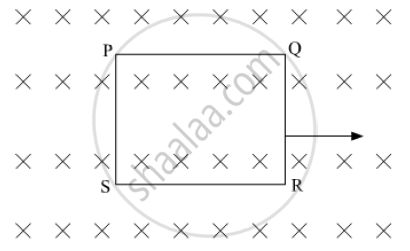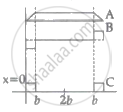Advertisements
Advertisements
Question
A (current vs time) graph of the current passing through a solenoid is shown in figure. For which time is the back electromotive force (u) a maximum. If the back emf at t = 3s is e, find the back emf at t = 7s, 15s and 40s. OA, AB and BC are straight line segments.

Solution
Whenever the electric current passing through a coil or circuit changes, the magnetic flux linked with it will also change. As a result of this, in accordance with Farraday's laws of electromagnetic induction, an emf is induced in the coil or the circuit which opposes the change that causes this induced emf is called back emf, the current so produced in the coil is called induced current. The induced emf is given by
`ε = - (d(Nphi_B))/(dt)`
`ε = - L (dl)/(dt)`
Thus, negative sign indicates that induced emf (e) opposes any change (increase or decrease) of current in the coil.
When the rate of change of current is maximum, then back emf in the solenoid is (u) a maximum. This occurs in AB part of the graph. So maximum back emf will be obtained between 5s < t < 10s.
Since, the back emf at t = 3s is e.
Also, the rate of change of current at t = 3
And slope(s) of OA (from t = 0s to t = 5s) = 1/5 A/s
So, we have
If u = L 1/5 (for t = 3s, `(dI)/(dt)` = 1/5)
Where L is a constant (coefficient of self-induction)
And emf is ε = `- L (dI)/(dt)`
Similarly, we have for other values
For 5s < t < 10s, u1 = `- L 3/5 = - 3/5 L = - 3e`
Thus, at t = 7s, u1 = – 3e
For 10s < t < 30s
u2 = `L 2/20 = L/10 = 1/2 e`
For t > 30s, u2 = 0
Thus, the back emf at t = 7s, 15s and 40s are – 3e e/2 and 0 respectively.
APPEARS IN
RELATED QUESTIONS
A circular coil of radius 8.0 cm and 20 turns is rotated about its vertical diameter with an angular speed of 50 rad s−1 in a uniform horizontal magnetic field of magnitude 3.0 × 10−2 T. Obtain the maximum and average emf induced in the coil. If the coil forms a closed loop of resistance 10 Ω, calculate the maximum value of current in the coil. Calculate the average power loss due to Joule heating. Where does this power come from?
The closed loop (PQRS) of wire is moved into a uniform magnetic field at right angles to the plane of the paper as shown in the figure, Predict the direction of the induced current in the loop.

The closed loop (PQRS) of wire is moved into a uniform magnetic field at right angles to the plane of the paper as shown in the figure. Predict the direction of the induced current in the loop.

A .0.5m long solenoid of 10 turns/cm has area of cross-section 1cm2 . Calculate the voltage induced across its ends if the current in the solenoid is changed from 1A to 2A in 0.1s.
The two rails of a railway track, insulated from each other and the ground, are connected to millivoltmeter. What is the reading of the millivoltmeter when a train passes at a speed of 180 km/hr along the track, given that the vertical component of earth’s magnetic field is 0.2 × 10–4 wb/m2 and rails are separated by 1 metre ______.
According to Faraday’s law of electromagnetic induction ______.
Faraday’s laws are consequence of the conservation of ______.
A magnetic field B is confined to a region r ≤ a and points out of the paper (the z-axis), r = 0 being the centre of the circular region. A charged ring (charge = Q) of radius b, b > a and mass m lies in the x-y plane with its centre at the origin. The ring is free to rotate and is at rest. The magnetic field is brought to zero in time ∆t. Find the angular velocity ω of the ring after the field vanishes.
The arm PQ of a rectangular conductor is moving from x = 0 to x = 2b outwards and then inwards from x = 2b to x = 0 as shown in the figure. A uniform magnetic field perpendicular to the plane is acting from x = 0 to x = b. Identify the graph showing the variation of different quantities with distance.


